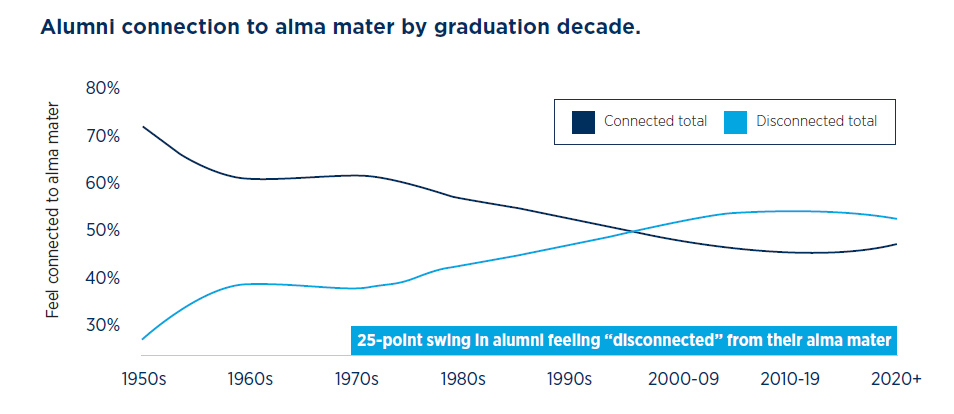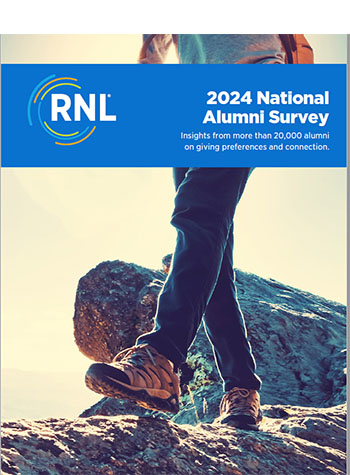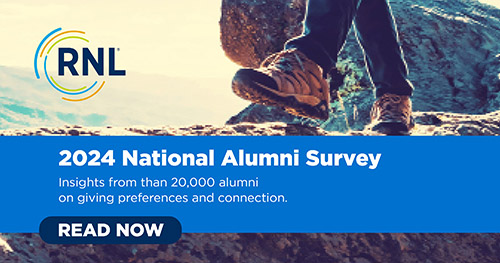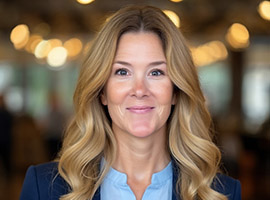fundraising
The Future of Higher Ed Fundraising: What Did We Learn From 20,000 Alumni?
This blog was written by Howard Heevner, a fundraising leader for more than two decades, serving in key giving roles at institutions including the University of Iowa, Penn State, The University of Michigan, DePaul University, and the University of California, Santa Cruz. Howard currently serves as executive director of annual programs at the University of California, Berkeley, a leadership role he has held since 2019. It was a pleasure to collaborate with Howard and 15 institutions participating in the RNL 2024 National Alumni Survey project.
RNL has just released the results of a survey with responses from more than 20,000 American higher education alumni. We invited alumni to share more about their giving and volunteering habits, their feeling of connection to their alma mater, and what inspires their generosity.
I’ve been honored to serve as a close advisor to this groundbreaking survey project. As I explained in the foreword to the research report, I’ve been thinking critically about how our behaviors as fundraisers do not match the way that people give today, and I’ve watched us suffer a massively declining alumni donor base. It’s time for new approaches.
Here are three insights alumni shared with us, and my take on what we need to do as fundraisers to transform how we connect with these populations, before it’s too late.
Connected and engaged alumni are ready to give, but there are too few of them
Older alumni feel much more synced to their alma mater, with only 46 percent of alumni from 2010 forward saying that they feel “connected.” Why does this matter? Our survey also tracked giving behavior, and alumni who feel connected are 23 times more likely to give.
Unfortunately, our fundraising outreach is geared to something totally different. Too often, our advancement systems are geared to chase wealth, and our outreach is about asking, not connecting. It’s clear from this survey that we should focus on building connection, which alumni are telling us is crucial in their giving decisions. Gifts follow connection.
It’s time to stop telling our alumni how to give and embrace their personal passions
We have two major challenges as fundraisers: First, our engagement systems don’t reflect who our alumni are today. And second, there is often resistance to changing the systems designed to meet these changing alumni needs.
We focus on big gifts. That’s not surprising, and in many ways it’s justifiable. We also approach givers with our institutional priorities, not their personal passions. The dollar amounts for “annual givers” are too low, and the donor’s value is viewed as too minimal by many advancement and institutional leaders. By necessity, these leaders think in terms of raising millions of dollars, which leaves them to invest minimally in innovation at “lower” donor levels.
I must admit, I am part of the system that has failed our alumni.
We are on the cusp of bringing incredible technology to our field, powered by predictive analytics and artificial intelligence. This technology allows us to better listen to alumni preferences and match up our outreach to their interests. As we do this, we must commit to using these new tools to listen to what our constituents value and present them with a greater breadth of opportunities, rather than force giving to areas we prioritize.
Alumni tell us they want to give to areas that meet mission, so let’s ask them
Intriguingly, younger alumni are very attuned to the key needs that we’re all trying to raise money for. Undergraduates of the last decade told us they are more likely to support mental health services, student emergency funds, DEI, and first-generation student initiatives—all areas that impact student success goals.

We’ve been trying for too long to “teach” alumni how to give. Today’s alumni, especially those in the millennial and Gen Z generations, give based on impact, what they’re passionate about, and in the ways they want to contribute—not how we tell them. It’s time for us to listen and reflect that we are listening to them.
Alumni are telling us they are ready to give for impact, based on connection
The RNL National Alumni Survey offers incredible insights for advancement professionals. I encourage you to download the full report.
I encourage you to think critically about how your engagement efforts can shift to better match the needs and preferences of today’s alumni. We have an opportunity to re-animate how alumni connect and ultimately support our institutions, but time is short. As we explain in the report, the declining alumni giving rates means we will soon face an alumni donor “cliff” as we lose older, loyalty-based givers. This cliff negatively impacts our pipeline of major gift prospects and will cause a potentially massive decline in overall giving.
The national survey marks the start of a project focused on the future of advancement work. I’ll be reaching out to fundraisers to facilitate small focus groups and 1:1 conversations to listen and learn more from you about how we can create transformational change. Drop me a line if you’d like to be part of it.
Read the National Alumni Survey
Discover insights from more than 20,000 alumni about their preferences, behaviors, and expectations for giving. Find out:
- How giving varies by alumni generation.
- How student debt impacts giving.
- How alumni connection and satisfaction changes based on race, gender, and graduation decade.


